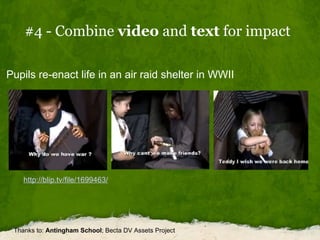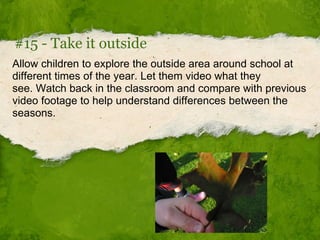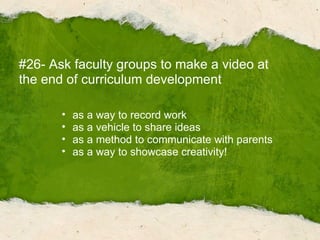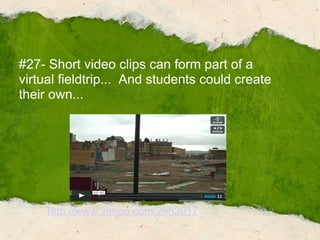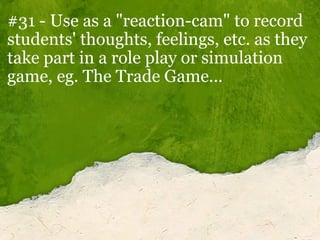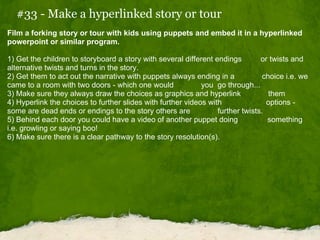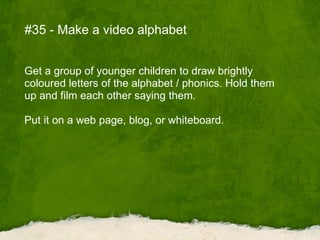42 Interesting Ways To Use Your Pocket
- 1. Forty-Two Interesting Ways* to use your Pocket Video Camera in the Classroom *and tips This work is licensed under a Creative Commons Attribution Noncommercial Share Alike 3.0 License.
- 2. Students work collaboratively to: Assign roles and responsibilities Create a storyboard to plan video clips Film step-by-step procedures Review & evaluate recorded material & re-shoot Combine final clips into one movie using video editing software, adding music if desired Publish final movie to a class blog, wiki, or DVD #1- Demonstrating Skill Sets with How-to Videos
- 3. #2 - Recording Science Experiments For evidence or record of results http://snipurl.com/alh2g
- 4. #3 - Take them on museum trips Video exhibits and displays http://snipurl.com/alh0s http://snipurl.com/alh4v
- 5. #4 - Combine video and text for impact Pupils re-enact life in an air raid shelter in WWII Thanks to: Antingham School ; Becta DV Assets Project http://blip.tv/file/1699463/
- 6. #5 - Challenge Children to Explain Quick & Dirty without much editing Another science one, with digital still camera BF (before flip): gears Some ideas for Small Scale Video in the classroom might help.
- 7. #6 Self-evaluation and group sharing of hands-on learning experiences More examples from Draft Horse and Agriculture classes at: http://www.youtube.com/sustainablesterling
- 8. #7 Interview an "Expert" Interview a classmate about a recommended book to read and why it should be read Interview a classmate about a how to solve a math problem image attribution: http://www.flickr.com/photos/whiteafrican
- 9. #8 - Film sports and PE for self/class evaluation
- 10. #9 - Collect group flip chart responses Video flip charts at the end of a lesson Put text from them into http://wordle.net to summarise views.
- 11. #10 - Film a school tour (in another language) Name places eg la piscina Say what you do there eg nado en la piscina Say which subject you study there eg hago la natación Say when you do it eg los lunes nado en la piscina Say whether you like it or not eg me gusta mucho nadar. Share and swap films with a partner school Compare & contrast!
- 12. #11 - Use your pocket video to share information/celebrations with parents Now that's what I call learning! Lori Feldman January 24, 2009
- 13. #12 - Walk around the playground at lunchtime and interview students on a topic Eg - Ask students what the best thing they did at school today was, what they like about school, what their favourite subject is and why, what they use computers for? Then use footage to inspire teachers in an inset or to inspire students in an assembly Footage from a Mino HD flip taken at Marinette Middle School Sample Video Clip from MMS
- 14. #13 - Record the key parts or key explanations in your lesson and put on your VLE Okay so pupils probably don't want to watch a 30-60 minute replay of your lesson, but... Why not record a brief explanation of a practical task or a written task with demos. Why not record the starter and plenary explanation for students to review. Keep it short and simple and it may just be useful!
- 15. #14 -Point of view movement Tape or tie it on, ( securely ), to a model car, turtle, shopping trolley, bike handlebars, etc; to get authentic point of view mobile footage. or Fasten it to yourself and get some point of view footage as you move around...
- 16. #15 - Take it outside Allow children to explore the outside area around school at different times of the year. Let them video what they see. Watch back in the classroom and compare with previous video footage to help understand differences between the seasons.
- 17. #16 - Assessment Ask children to video what they have been doing. Even 3 and 4 year olds can video their friends explaining favourite activities. Use the footage at open days, parents evening, but more importantly as a window on the ideas and learning experiences of the children in your classes, who will talk differently when you are not in ear shot!
- 18. #17 - Encourage collaboration Set a puzzle for the class (such as a problem solving coin/matchstick puzzle) and encourage children to video their solutions. The difference in clarity of explanation is massive when the children know they are going to video it- try it and see!
- 19. #18 - Special Needs - Deaf children Students use camera to film spellings signed by teacher at school so they can take it home to learn & share with siblings/parents. Read more: http://snipurl.com/aoqbo Image attribution: http://snipurl.com/aossx Jenny Ellwood 2009
- 20. Good examples of classroom practice /content teaching can serve as guidelines for other/novice teachers. Short snippets of "How I teach that" can be very useful for professional development. #19 - Professional Development image attribution: http://www.flickr.com/photos/thomaschristensen/2234598002/
- 21. Video clips can be great for slowing down any quick moving action. Clips can be edited and slowed down permanently or can be played back in QuickTime player - which allows you to scrub through the time-line or press the cursor keys to advance or 'rewind'. #20 - Slowing down action image attribution: http://www.flickr.com/photos/morganmorgan/1661707859/ You can also grab a sequence of stills to print out and show the steps of the captured action.
- 22. Get your 1st Year (Secondary School) pupils to create a film tour of the school for incoming Primary School children. Encourge pupils to create a film of their experience of their first year at Secondary School Film a tour of the school in order to make the incoming year at ease with their surroundings.Interview teachers from different subject areas. Give the pupils complete control over the editing process and final version which they will present to the Primary School pupils on their induction day(s). #21 - Use it as part of your Primary Induction
- 23. For national poetry day this class was challenged to make a visual version of a poem using any means available to them, for example some used Comic Life. This group used video and captured the atmosphere of the poem well, despite filming in an empty maths room! #22 - Challenge class to make a visual representation of a poem
- 24. #23 - Review Student Composition and Performance Students use video to collect composition ideas Use video to share and collaborate Post video performance and composition on student blogs Improve technique and presentation skills Year 5 Ensemble Performing Un Poco de Cinco
- 25. ...and see if they keep their heads and arms hidden from the camera during the filming! #24 - Record children performing a (shadow) puppet show they have created... Image attribution: www.flickr.com/photos/15757729@N00/2571821462
- 26. ...and watch as they keep asking over and over to try it again to make it even better! #25 - Have your students make a commercial when they have finished a book... I
- 27. as a way to record work as a vehicle to share ideas as a method to communicate with parents as a way to showcase creativity! #26- Ask faculty groups to make a video at the end of curriculum development
- 28. #27- Short video clips can form part of a virtual fieldtrip... And students could create their own... http://www.vimeo.com/2953917
- 29. #28 Record Video Introduction for a partner class, when live video conferencing is inconvenient or impossible due to time zones
- 30. #29 - Children film promotional adverts for clubs that run at your school. This could of course be the promotion of any aspect of the school, but clubs are of direct relevance to the children.
- 31. #30 - A class carries out peer assessment on work by students at another school, posted on a blog
- 32. #31 - Use as a "reaction-cam" to record students' thoughts, feelings, etc. as they take part in a role play or simulation game, eg. The Trade Game...
- 33. #32 - As a motivational tool Children were highly motivated by today's task as they all wanted to video their results and present them to the class. Children who previously would have given up were keen to become cameramen or women for the minute!
- 34. #33 - Make a hyperlinked story or tour Film a forking story or tour with kids using puppets and embed it in a hyperlinked powerpoint or similar program. 1) Get the children to storyboard a story with several different endings or twists and alternative twists and turns in the story. 2) Get them to act out the narrative with puppets always ending in a choice i.e. we came to a room with two doors - which one would you go through... 3) Make sure they always draw the choices as graphics and hyperlink them 4) Hyperlink the choices to further slides with further videos with options - some are dead ends or endings to the story others are further twists. 5) Behind each door you could have a video of another puppet doing something i.e. growling or saying boo! 6) Make sure there is a clear pathway to the story resolution(s).
- 35. #34 - Work Experience After introducing your student (and placement contact) to the camera, send it along with them and any work experience documentation. Consider which written responses during or after the placement could be recorded rather than written. Remember, students are turned off by many PSE/PSD process and evaluation worksheets/assessments.
- 36. #35 - Make a video alphabet Get a group of younger children to draw brightly coloured letters of the alphabet / phonics. Hold them up and film each other saying them. Put it on a web page, blog, or whiteboard.
- 37. #36 - Conference Documentary Record a documentary of your experience at a con- ference. Upload the video and embed it in a classroom blog for your students to learn from their teacher. I recorded the video below at the 2009 CSUN Conference on Technology & Persons with Disabilities. I embedded it in my blog, and showed it to my students so they could learn about new technology. Contributed by Eric Sailers, who embedded the video in his blog at Speech-Language Pathology Sharing .
- 38. #37 - Video modeling of social language Record a regular education student demonstrating a social language skill. Have the student contrast the inappropriate behavior with the appropriate behavior. I recorded the video below with a regular education student and a fellow Speech-Language Pathologist. I embedded it in my blog, and showed it to my students so they could learn when to stay quiet. Contributed by Eric Sailers, who embedded the video in his blog at Speech-Language Pathology Sharing . Click here for video
- 39. Stick it in a pupils blazer pocket for a pupil view of a trip/walk/experience #38 - Blazercam
- 40. Let children video themselves in front of a blue background. (We interviewed famous Romans!) Put the video into authoring software, add an authentic background image, add chroma-key filters and watch your pupils travel back in time! A. Lydon '09 #39 - Chroma-key
- 41. #40 - Observing Weather Conditions Place your video camera on a window ledge and leave it recording for a period of time Playback to watch the weather: Look at a rainbow appear/disappear See lightning strike @simonhaughton Image attribution: http://www.flickr.com/photos/55288032@N00/230371538/ Image attribution: http://www.flickr.com/photos/73835037@N00/1045362101/
- 42. #41 Digital Chicken Soup Keep students who are out sick connected. Have students film a mini lesson or a class review using the video cameras. Embed the videos in a class blog. The students at home can comment on the blog and answer the same questions that the students in class answered. Students saying 'feel better' or 'we miss you' is acceptable as long as it is not disruptive. Image Elana's Pantry
- 43. #42 Beebot's eye view Use a gorillapod and some insulating tape (I know - very high tech) to attach the camera to a BeeBot and record the Beebot's journey. It's easy to position the gorillapod's legs so they do not interfere with the controls - the tape just gives extra stability. @bevevans22
- 44. If you would like to: Contribute your ideas and tips to the presentation. Let me know how you have used the resource. Get in touch. You can email me or I am @ tombarrett on Twitter Thanks for helping Tom Barrett Image: ‘ Sharing ‘ If you add a tip (or even if you don't) please tweet about it and the link so more people can contribute. I have created a page for all of the Interesting Ways presentations on my blog . The whole family in one place :-) Have you seen Maths Maps yet?





